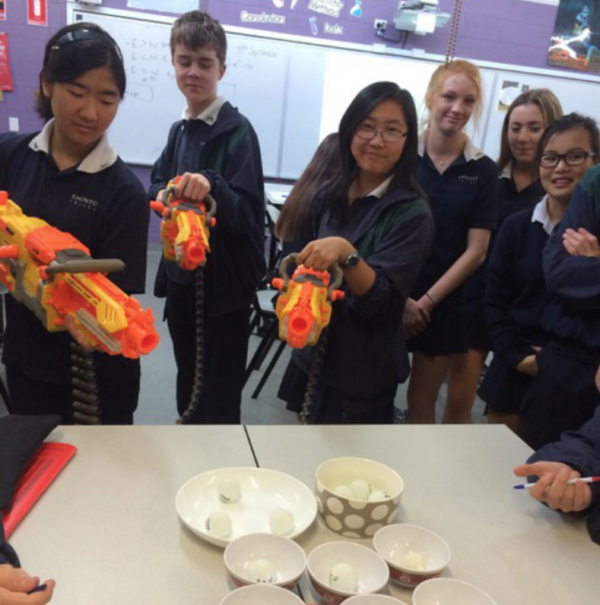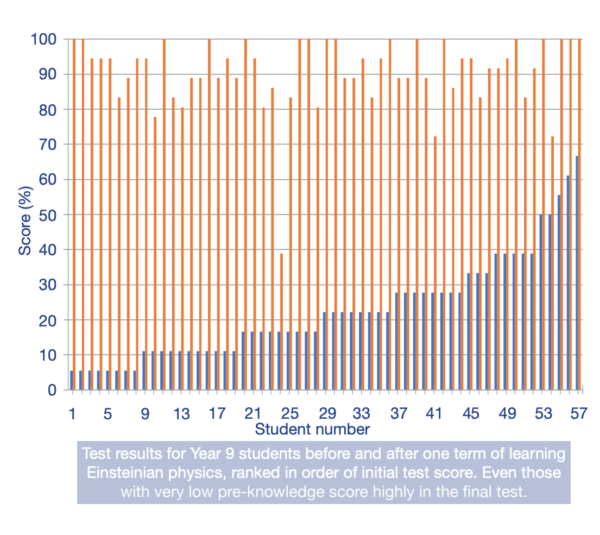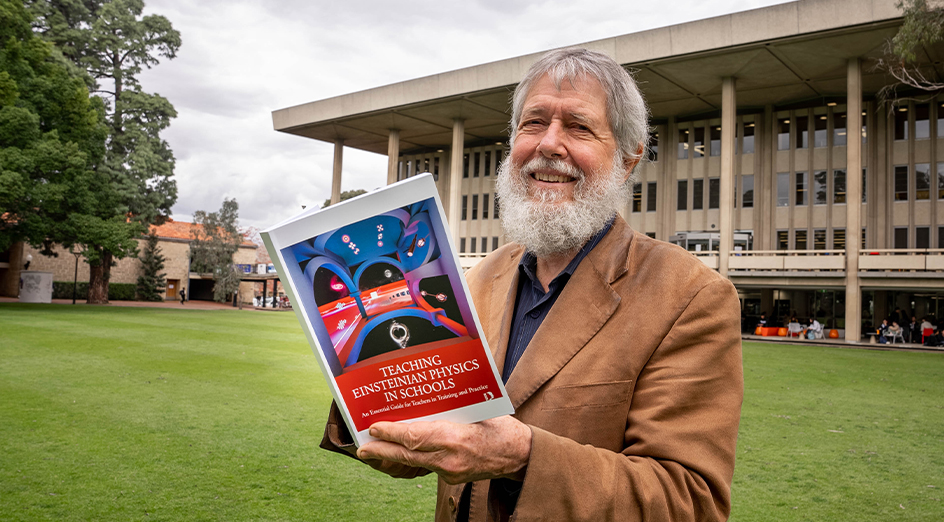Australia’s National Science Week is well underway, and a bunch of professors who have never lost the passion for fundamental physics have over the past eight years developed a new Australian primary-school science curriculum for school Years 3-10, to inform the everyday discussions children hear about climate change, renewable energy, time warps, quantum physics and other fascinating topics.
“Everyone has the right to share our best understanding of physical reality,” says the University of Western Australia’s Emeritus Professor David Blair, a winner of last year’s Prime Minister’s Prize for Science, who says children know they’re not being taught science topics relevant to their daily lives.
Blair and one of three other joint winners of the PM’s award, Professor Susan Scott, a professor of quantum science at the Australian National University, are leading an international team of academics to arrest the decline of interest shown by students in science from about the age of 14, with a new seamless progression of learning — dubbed the Einstein-First Project — based around a book, Teaching Einsteinian Physics in Schools, and an accompanying confidence-building program for teachers.
The key to the program is bringing science into the present, with all we know about photons (cue photovoltaics), light, energy and carbon dioxide in the atmosphere, demonstrated using cheap thrills such as Nerf guns, magnets in tennis balls and more sophisticated donated equipment such as real solar panels which are then used to power tools such as drills, LED lights and more.
The fascination of relevance
“Most children have heard of black holes and E=mc2,” Blair told pv magazine Australia, but the school curriculum is still focused on 19th-century science, where time is absolute, geometry is Euclidean and mass does not change with energy. It’s no surprise, he says, that kids think school science is about old stuff.
In the 19th century people had already observed many scientific phenomena that preceded our current understanding of climate change. The new Einstein-First curriculum reveals that as early as 1848, people were astonished to discover that heat, or what they then called “calorific white rays” would not pass through carbon dioxide or methane. In 1896, in Sweden, Arrhenius predicted that if the CO2 in the atmosphere were to double, then the temperature of the earth would increase by about five degrees.
“This is basic physics,” says Blair, and you can understand why there could be climate scepticism when people don’t understand why tiny amounts of some atom or molecule in the atmosphere can have this effect.”
Understanding such concepts is key to our survival, and also to igniting children’s comprehension that leads to questioning and scientific exploration.
Turning the ocean liner of curriculum
Blair’s group of scientists began by interviewing children to appreciate what turns them off science, and started also to tackle many teachers’ reluctance to bring physics into the classroom, by making it approachable and engaging.
“Einsteinian physics is imagined by most adults to be impossibly difficult, but young people easily accept the concepts,” says Blair. He adds that the belief propagated by the founder of educational theory, Jean Piaget, that children can’t understand conceptual things until about the age of 14 have been debunked.
Never mind that, “When Piaget was talking about it, atoms were still conceptual; now you can see them and see molecules using atomic force microscopes and other methods,” he says.
The modernising scientists have developed and trialled a program of activities based on analogies and physical models, in which 15 Western Australian schools have participated. Teachers are introduced to the program in small workshops, and PhD students make time to visit schools and help teachers lead children through the activities.
Photovoltaics are built on Einstein’s discoveries
“One of the earliest things we teach kids is the principles of the photoelectric effect — which Einstein discovered in 1905 — how photons can basically knock electrons out of metals,” a concept teachers can demonstrate by using bowls of ping-pong balls as electrons and Nerf-gun-propelled electrons to knock them out of the bowl.

Image: Einstein-First Project
Access Technology Group has so far donated solar panels to participating schools. “It’s not a solar toy, but a full-scale solar panel that has enough power to run a 12-Volt electric drill which we might then use to create heat through friction.” says Blair. “It’s at a level of tactile experience where you can feel the forces,” he adds.
Such real equipment, physical models and toys encourage students to discover concepts through whole-body involvement. The concepts are also encapsulated in little ditties — songs that young children love to recite.
The program encourages children to tell the “stories of discovery, the overthrow of old ideas and the language of modern science”, says a flyer produced to help generate private funding that will allow the group to scale their Einstein-First program into online teacher workshops, learning modules and support.
UWA, ANU and Curtin Universities have participated in development of the program, with about $1.5 million in combined funding from the Australian Research Council and the Western Australian Government.
The launch of the teacher-enabling book Teaching Einsteinian Physics in Schools on Wednesday this week will also see the beginning of a quest for a further $1 million in private funds to create online teacher-training materials and videos needed to roll the new curriculum out Australia wide.
The initiative is also seeking commitments to provide materials in kind — more solar panels, electric drills, fans and LED lights.
“Solar energy is 100% connected to Einsteinian physics,” says Blair. A solar panel, even kept inside the classroom, gathers enough light to power an LED globe, “and it just triggers so much physics and discussion: You’re starting with photons, you’re making electrons, then you’re using the electrons to directly convert back into photons in the LED light — the same physics in reverse!” says Blair.
Teachers give Einstein-First a glowing report card
Teachers who have been using Einstein-First materials in the classroom and providing feedback to the course leaders on what works and what doesn’t, have reported incredible results.
Blair says one Year 7 teacher who teaches a class that includes children with Attention Deficit Disorder and some learning disabilities told him that all students became fully engaged with the activities, “disruption was rare”, and that during activities and in post-activity discussions, “students with learning difficulties are practically indistinguishable from mainstream students”.
A Year 3 teacher said the program “stretched” the students, and at the end of classes they were “using vocabulary and clearly understanding concepts that would normally not be introduced until high school”.
Test scores bear out teachers’ personal experience of teaching using Einstein-First:

To contribute to the rollout of the Einstein-First Project, and to learn more about its development and results, visit www.einsteinphysics.com/
This content is protected by copyright and may not be reused. If you want to cooperate with us and would like to reuse some of our content, please contact: editors@pv-magazine.com.









By submitting this form you agree to pv magazine using your data for the purposes of publishing your comment.
Your personal data will only be disclosed or otherwise transmitted to third parties for the purposes of spam filtering or if this is necessary for technical maintenance of the website. Any other transfer to third parties will not take place unless this is justified on the basis of applicable data protection regulations or if pv magazine is legally obliged to do so.
You may revoke this consent at any time with effect for the future, in which case your personal data will be deleted immediately. Otherwise, your data will be deleted if pv magazine has processed your request or the purpose of data storage is fulfilled.
Further information on data privacy can be found in our Data Protection Policy.